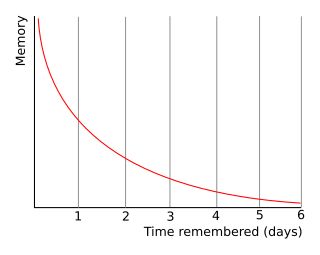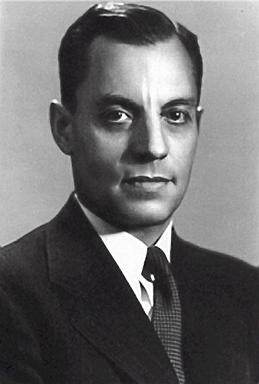
The design of experiments, also known as experiment design or experimental design, is the design of any task that aims to describe and explain the variation of information under conditions that are hypothesized to reflect the variation. The term is generally associated with experiments in which the design introduces conditions that directly affect the variation, but may also refer to the design of quasi-experiments, in which natural conditions that influence the variation are selected for observation.

The forgetting curve hypothesizes the decline of memory retention in time. This curve shows how information is lost over time when there is no attempt to retain it. A related concept is the strength of memory that refers to the durability that memory traces in the brain. The stronger the memory, the longer period of time that a person is able to recall it. A typical graph of the forgetting curve purports to show that humans tend to halve their memory of newly learned knowledge in a matter of days or weeks unless they consciously review the learned material.

Ancel Benjamin Keys was an American physiologist who studied the influence of diet on health. In particular, he hypothesized that replacing dietary saturated fat with polyunsaturated fat reduced cardiovascular heart disease. Modern dietary recommendations by health organizations, systematic reviews, and national health agencies corroborate this.
Experimental psychology refers to work done by those who apply experimental methods to psychological study and the underlying processes. Experimental psychologists employ human participants and animal subjects to study a great many topics, including sensation, perception, memory, cognition, learning, motivation, emotion; developmental processes, social psychology, and the neural substrates of all of these.
Hebbian theory is a neuropsychological theory claiming that an increase in synaptic efficacy arises from a presynaptic cell's repeated and persistent stimulation of a postsynaptic cell. It is an attempt to explain synaptic plasticity, the adaptation of brain neurons during the learning process. It was introduced by Donald Hebb in his 1949 book The Organization of Behavior. The theory is also called Hebb's rule, Hebb's postulate, and cell assembly theory. Hebb states it as follows:
Let us assume that the persistence or repetition of a reverberatory activity tends to induce lasting cellular changes that add to its stability. ... When an axon of cell A is near enough to excite a cell B and repeatedly or persistently takes part in firing it, some growth process or metabolic change takes place in one or both cells such that A’s efficiency, as one of the cells firing B, is increased.
Psychophysics quantitatively investigates the relationship between physical stimuli and the sensations and perceptions they produce. Psychophysics has been described as "the scientific study of the relation between stimulus and sensation" or, more completely, as "the analysis of perceptual processes by studying the effect on a subject's experience or behaviour of systematically varying the properties of a stimulus along one or more physical dimensions".

Memorial Stadium, also known as the "Brick House", was an outdoor athletic stadium in the north central United States, located on the campus of the University of Minnesota in Minneapolis. It was the home of the Minnesota Golden Gophers football team for 58 seasons, from 1924 through 1981. Prior to 1924, the Gophers played at Northrop Field.
In economics, hyperbolic discounting is a time-inconsistent model of delay discounting. It is one of the cornerstones of behavioral economics and its brain-basis is actively being studied by neuroeconomics researchers.
Calorie restriction is a dietary regimen that reduces the energy intake from foods and beverages without incurring malnutrition. The possible effect of calorie restriction on body weight management, longevity, and aging-associated diseases has been an active area of research.
The two-factor theory of emotion posits when an emotion is felt, a physiological arousal occurs and the person uses the immediate environment to search for emotional cues to label the physiological arousal.

The Civilian Public Service (CPS) was a program of the United States government that provided conscientious objectors with an alternative to military service during World War II. From 1941 to 1947, nearly 12,000 draftees, willing to serve their country in some capacity but unwilling to perform any type of military service, accepted assignments in "work of national importance" in 152 CPS camps throughout the United States and Puerto Rico. Draftees from the historic peace churches and other faiths worked in areas such as soil conservation, forestry, fire fighting, agriculture, under the supervision of such agencies as the U.S. Forest Service, the Soil Conservation Service, and the National Park Service. Others helped provide social services and mental health services.

Mental chronometry is the scientific study of processing speed or reaction time on cognitive tasks to infer the content, duration, and temporal sequencing of mental operations. Reaction time is measured by the elapsed time between stimulus onset and an individual's response on elementary cognitive tasks (ECTs), which are relatively simple perceptual-motor tasks typically administered in a laboratory setting. Mental chronometry is one of the core methodological paradigms of human experimental, cognitive, and differential psychology, but is also commonly analyzed in psychophysiology, cognitive neuroscience, and behavioral neuroscience to help elucidate the biological mechanisms underlying perception, attention, and decision-making in humans and other species.

Stanley Schachter was an American social psychologist best known for his development of the two factor theory of emotion in 1962 along with Jerome E. Singer. In his theory he states that emotions have two ingredients: physiological arousal and a cognitive label. A person's experience of an emotion stems from the mental awareness of the body's physical arousal and the explanation one attaches to this arousal. Schachter also studied and published many works on the subjects of obesity, group dynamics, birth order and smoking. A Review of General Psychology survey, published in 2002, ranked Schachter as the seventh most cited psychologist of the 20th century.
Free recall is a common task in the psychological study of memory. In this task, participants study a list of items on each trial, and then are prompted to recall the items in any order. Items are usually presented one at a time for a short duration, and can be any of a number of nameable materials, although traditionally, words from a larger set are chosen. The recall period typically lasts a few minutes, and can involve spoken or written recall. The standard test involves the recall period starting immediately after the final list item; this can be referred to as immediate free recall (IFR) to distinguish it from delayed free recall (DFR). In delayed free recall, there is a short distraction period between the final list item and the start of the recall period. Both IFR and DFR have been used to test certain effects that appear during recall tests, such as the primacy effect and recency effect.

The University of Minnesota School of Public Health (SPH) is located in Minneapolis, Minnesota, a politically and socially progressive city, and it is fully accredited by the Council on Education for Public Health. In 2022, the school enrolled more than 1,000 students from 48 different countries. Its 123 full-time faculty members manage the #3 most highly funded research portfolio at the University of Minnesota. Within 12 months of graduation, 99% of the school’s students are employed in their fields.
Hydrostatic weighing, also referred to as underwater weighing, hydrostatic body composition analysis and hydrodensitometry, is a technique for measuring the density of a living person's body. It is a direct application of Archimedes' principle, that an object displaces its own volume of water.
The plateau principle is a mathematical model or scientific law originally developed to explain the time course of drug action (pharmacokinetics). The principle has wide applicability in pharmacology, physiology, nutrition, biochemistry, and system dynamics. It applies whenever a drug or nutrient is infused or ingested at a relatively constant rate and when a constant fraction is eliminated during each time interval. Under these conditions, any change in the rate of infusion leads to an exponential increase or decrease until a new level is achieved. This behavior is also called an approach to steady state because rather than causing an indefinite increase or decrease, a natural balance is achieved when the rate of infusion or production is balanced by the rate of loss.

Sprinting involves a quick acceleration phase followed by a velocity maintenance phase. During the initial stage of sprinting, the runners have their upper body tilted forward in order to direct ground reaction forces more horizontally. As they reach their maximum velocity, the torso straightens out into an upright position. The goal of sprinting is to reach and maintain high top speeds to cover a set distance in the shortest possible time. A lot of research has been invested in quantifying the biological factors and mathematics that govern sprinting. In order to achieve these high velocities, it has been found that sprinters have to apply a large amount of force onto the ground to achieve the desired acceleration, rather than taking more rapid steps.
Henry Cedric Scholberg was director and librarian of the Ames Library of South Asia at the University of Minnesota. His works include bibliographies on Indian encyclopedias, on manuals and gazetteers of India, and on the Portuguese in India. He also authored other scholarly works, plays and novels, as well as his own memoirs.
Set point theory, as it pertains to human body weight, states that there is a biological control method in humans that actively regulates weight towards a predetermined set weight for each individual. This may occur through regulation of energy intake or energy expenditure. Set point theory explains why it is difficult for dieters to maintain weight loss over time, as calorie restriction may become less effective or more difficult to maintain as regulatory mechanisms in the body actively push the body back towards the set point weight.




















